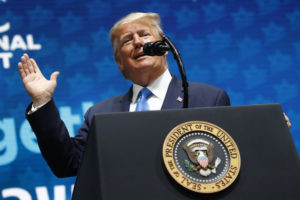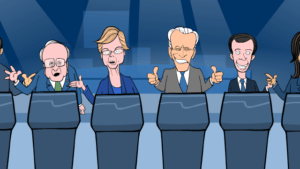Are Political Cartoonists an Endangered Species? (Video and Transcript)
The Truthdig team sat down with a special guest: acclaimed political cartoonist Dwayne Booth (aka Mr. Fish), who discussed the challenges of disseminating controversial views.
Political cartoonist Dwayne Booth — who goes by the pen name Mr. Fish — doesn’t hold back in his wry depictions of politics, pop culture and 21st century capitalist life. “[T]here is no more savage yet brilliant wit than that possessed by Mr. Fish,” says Truthdig Editor in Chief Robert Scheer. “In a sellout culture, he is that rare witness for unfettered truth.”
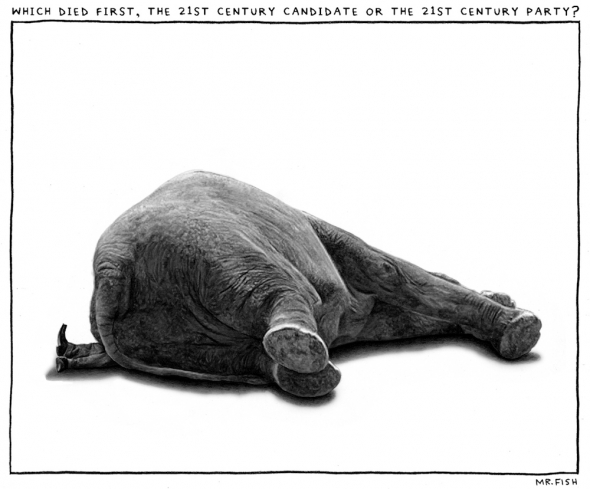
On Thursday, Mr. Fish joined the Truthdig team for a discussion streamed live on our Facebook page. The full video is posted below.
Mr. Fish recently returned from Philadelphia, where he created sharp, illuminating illustrations of the activism taking place outside the Democratic National Convention.

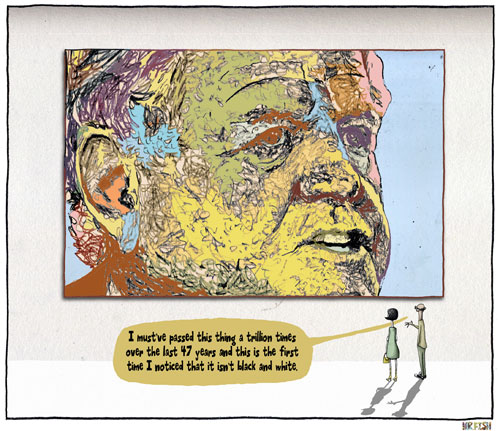
In this unprecedented election season, how does Mr. Fish approach the political climate? How can art, satirical or not, affect contemporary politics? And, as an established political cartoonist, what are Mr. Fish’s goals during this political season?
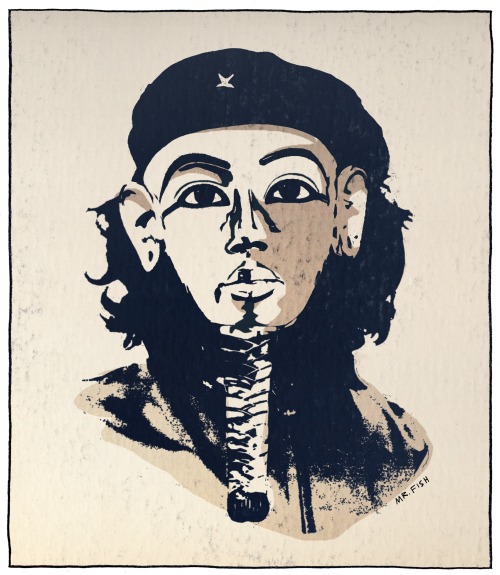
Mr. Fish created the above illustration during the height of the Egyptian revolution of 2011, and the image was later used on signs by Egyptian protesters. He’s also created original illustrations for reports by fellow Truthdig contributor Chris Hedges — “Mind Rape and the Christian Right” and “Bowl Phone Sex.”
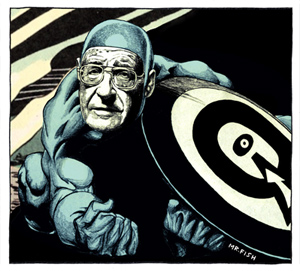
He also interviewed Noam Chomsky for Truthdig in 2008 and created the above illustration to accompany their conversation.
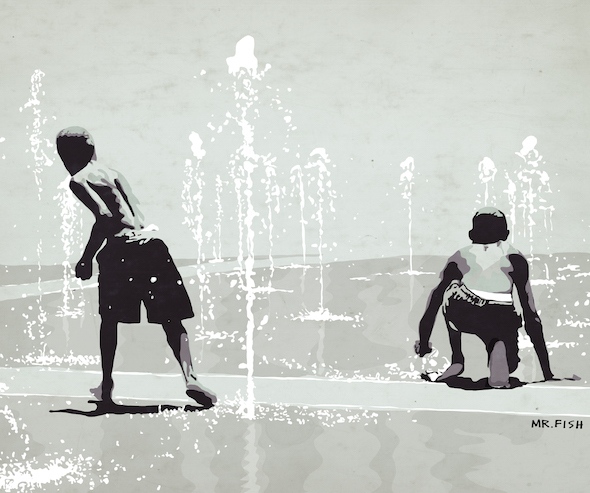
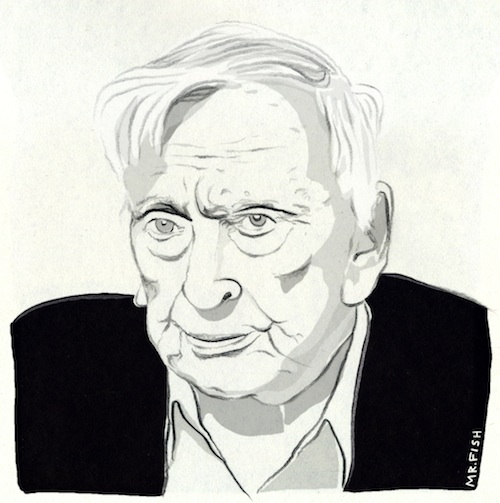
Watch the full conversation below. The transcript of the discussion is posted underneath the video. For past editions of “Live at Truthdig,” visit our YouTube page.
Sarah Wesley: Welcome, everyone, to Live at Truthdig. I’m your host, Sarah Wesley, communications coordinator here at Truthdig. Today we are joined by a very special guest, one of our very own Truthdig cartoonists, illustrator and so much more; we’re going to get into all of his great experience in a little bit. We’re also joined with our publisher, Zuade Kaufman, who will be tuning in and chiming in with the conversation; and of course, staff writer Emma Niles. We’ll be looking at your Facebook comments and questions, so have a field day right below this video and send us anything you find interesting. Let’s get into it! Mr. Dwayne Booth, aka Mr. Fish!
Dwayne Booth: Mm-hmm.
SW: Thank you for being here today and for joining us and coming out and showing your face when usually we just see your illustrations.
DB: Yes, yeah.
SW: So thank you. Mr. Fish, aka Dwayne, has a book. It’s called “Go Fish,” if you guys are interested in looking at any of his illustrations, right here. He also has been with Truthdig pretty much since the inception of Truthdig. We have been known to publish a lot of his work that might not otherwise be published in other major publications because of the nature of what he talks about. It’s very interesting, sometimes controversial — [laughter]
DB: Sometimes.
SW: — sometimes controversial, but in our opinion, very important. Especially in this political climate. So let’s get into what’s going on right now in 2016.
DB: You want me to answer that question?
EN: As a cartoonist, are you having a field day right now with the election and all the craziness, or — ?
DB: No. Absolutely not. No. I get that all the time: “You must be in heaven with basically the lunacy and the absurdity of the campaign.” And to me, you don’t need a comedic interpretation of something that is already very darkly comic and very tragic in a really idiotic way. Because a cartoonist really wants to get to the bottom of how politics function and why they don’t function, and how they are applied to society. When you’re in an election season, the conversation usually gets dumbed down to be so simplistic that there’s no room for any deep interpretation of anything. But it makes sense, because when you think about it, election campaigns are promoted and supported largely by the mainstream media. It’s a mainstream event, right? So when you apply, when you look at the carrier of the conversation being mainstream, do you go to the mainstream to figure out intellectual conversation? Meaningful, deep-diving conversation about things that are really relevant? No, you don’t. It’s embarrassing. So it’s a shame that the volume on what the democracy should look like, and how it should function, is relegated to now the loudest voice, which is the mainstream voice. It’s nonsense. It’s platitudes. Even when you look at how the conversation goes about what each side is saying, Trump and Hillary. Usually, it’s not about the content; it’s usually about strategy. So often it’s just somebody said something which is definitely – like, what did Trump recently say? He said something about Hillary Clinton is a bigot.
Emma Niles, SW: Yeah.
DB: All right, Hillary is — [gestures, throwing hand out] So now it’s just like OK, how are the Hillary people going to deal with this? What does he really mean by this? And it’s, if somebody was in your house and trying to have a political conversation with you, and said that? It’s just like, oh, are you kidding me? What are we, 6 years old? The real issues are something that don’t involve the kind of conversation that the mainstream and what most people are talking about in politics now.
SW: So with your art, what —
Zuade Kaufman: Actually, I want to ask, before we move away from that — so what you’re saying is that in a way, they’re somewhat of cartoons in themselves. And what becomes a topic for you that makes them a cartoon, and does it ever become sort of — when are they metaphor, when are you making a cartoon of it, when is it almost like you’re reporting on or chronicling what’s going on? Where do you draw those lines?
DB: I think that’s where my cartoons are different than a lot of cartoonists that are working now. Because I don’t do what a lot of editorial and political cartoonists are doing now — I don’t pick a side. And if you look at a lot of – most, I would say — it’s very hard to find a political cartoonist who creates art during a campaign season where they haven’t picked a side and then argue against the person that they don’t like. Mostly, now, it’s Trump. So therefore you can draw Trump, you know, being a loudmouth — there’s no creativity in that. He’s obviously a shrill, shallow person; his tactic is to not have meaningful conversation. You know, it’s about riling up the simplest, the dimmest wits on the block.
Because if we just look at it this way here — let me say it this way: As somebody who’s trying to inspire votes in a democracy such as ours, what you’re trying to do is — you have to appeal to the stupidest people out here to get them either scared or excited to give you their vote. So you say stupid, simplistic things, you get those people riled up. OK. So you got those people on your side. Now there’s people that are a little more intelligent than the people on the periphery, right? And so they’re going to be an apologist for the shrillness of your message as a politician, because what they say is, well, the person that I will eventually vote for has to say that to get votes.
And we don’t even have to talk about Trump. It happened with Obama when Obama was first running. People were very excited, I was very excited. A, because he wasn’t anything like Bush and it was very easy to sort of read a candidate as being Gandhi because he was the opposite of what we had with Bush, right? So then people got very, very excited, and then as Obama got closer to Election Day, there were certain things that he started to fall away on. He started to sound a little more hawkish, and he started to bend his — what you thought was a great, moral leader started to reveal himself as a politician. So the smartest people were still saying, yes, I disagree with him on this, but come on, he has to say that to become elected.
So then what happens to logic, and what happens to holding people’s feet to the fire when it comes to something where you’re electing who is supposed to be the most powerful person on the planet? And is connected to multinational corporations and this huge machinery that threatens the species. That’s not a place where you sort of are going to be like, OK, the strategy is, let them be a pig, let them be dangerous, let them allow the power to exist where it exists inside the machinery that supports them and gets them into office. Nothing will change, and everything will steadily get worse.
ZK: So then when is your point of knowing when to enter kind of your role as a cartoonist or your role — what inspires you and when is the moment when you feel like your word will, your illustration will make a difference?
DB: That’s the important question. Because, and that’s how you measure and you judge if it’s a successful cartoon or not, in my opinion, just as it is a successful and meaningful piece of journalism, writing, commentary of any sort. It has to reflect the humanity that is being threatened. If you approach your subject matter as … you want to demonstrate or indicate that people are vulnerable, people need to be saved. And I’m talking about species. I’m not talking about just Republican, Democrat. Because once it gets into that thing, then it’s cheap, like I was saying. So if you’re going to enter into a political conversation, don’t enter in where it’s this, where you might as well be talking about sports. You want to create a piece of art that then reflects what you’re trying to communicate as a human being to other people who will then be able to take that breath and be like, hey, there are things at stake that are serious, much more serious than playing politics.
SW: So, with your art, is that the main goal of your illustrations, to bring awareness? Or do you have other ideas of what you’d like to evoke in people’s minds or feelings? Or what is that ultimate goal that you’d like to accomplish for the viewer?
DB: To use every method that I can to disrupt what they assume they think. Because I think a lot of what people believe is a reflective thinking. You know, you’re raised to think “America’s the greatest nation” — you know, anybody, everybody outside the United States is sad that they’re not in America. Right?
SW: Not all. But that’s the perception.
DB: Yeah, I know, that’s what I’m saying: that there’s a lot of people that have that somewhere inside them. That is demonstrated somewhere – [say] pirates have taken, attacked an American vessel somewhere. “They can’t do that to Americans!”
SW: Right, right.
DB: So there’s that kind of concept, this broad sense of this. But these are reflective thinking. You know — our troops, support the troops because they’re heroes. And then all of a sudden, the conversation is such where it’s – heroes? OK, can we have any critical conversation about what soldiers do in foreign policy that might be criminal? So it becomes a difficult conversation. So my job as a cartoonist — and I think a job of a cartoonist, historically speaking, it was much truer — is to disrupt these assumptions that people have that make them have an internal conversation like “Wait a minute; do I really believe that?” And then if you make it provable, and there’s plenty of proof in the world to say, no, you can’t be an apologist for certain things and ignore certain things, because there’s truisms that prove you to be wrong. So it’s basically giving them information. Because I think it’s not about stupidity, it’s about ignorance; ignorance is when you don’t know it’s there.
ZK: You know, this reminds me, we’ve been at this a long time together. [Laughs] It reminds me of your story that you told me that during the Egyptian revolution, which — you told me that you had sort of a thought in the middle of the night where there was a juxtaposition of pharaoh and Che Guevara, and you woke up and you illustrated this, and by the morning you watched the internet and you saw people in the streets with images —
SW: This is it, right here. [Holds up a mug depicting Mr. Fish’s Walk Like an Egyptian.”]
DB: In Tahrir Square, yeah.
ZK: In [Tahrir] Square, with the image. And it became part of the protest. So also a little bit of the interaction between you and the audience.
DB: [Picks up the mug.] Yeah, and that’s what this is — something like this, which is a wordless cartoon, and that’s the beauty of cartoons. You can be illiterate, and you can understand what the cartoonist is trying to say. You’re right, the revolution was going on and I was drifting off to sleep, and this came to mind; it’s just the perfect marriage and the perfect statement for this. And I just sighed, and my wife was just like, what’s the matter? And I’m like, I just thought of a cartoon. [Laughter] And what she said was — and you know this as a journalist — she said, just wait till morning. And you know you can’t wait — [Emma Niles holds out a print of “Walk Like an Egyptian”] Oh, there it is.
SW: The creativity, sometimes —
DB: Yeah, you can’t wait till morning because you have it in your head, where — to me, all of a sudden it becomes so obvious. It’s just like, I can’t, I won’t be able to go to sleep until I’ve rendered this on paper. So I did, I got up and then I worked until like 2 in the morning. Sent it to you —
ZK: How often is it obvious when you do a cartoon or an illustration, versus where you’re really pushing to get at a point?
DB: It’s rare. And it’s usually the ones that don’t have text. Because text can make the argument convoluted. Even as clear as you want to get, there’s always going to be somebody who says like, “Well, you know, grr.” Because you’re reducing it to an intellectual argument, which has many sides. When you do something with an image, there’s a visceral reaction people have; you get it, and the meaning of it happens in your periphery. That’s what poetry is; it keeps it here. But just to finish that point, you were right: I get up the next morning and then it was everybody, it was already turned into T-shirts by the time I woke up.
ZK: And could you tell us a little bit about your coverage of the [Democratic National Convention] for Truthdig that you just did? You also had a kind of, ah, some inspired moments. Can you tell us a little bit about that?
DB: Absolutely. You know, we communicated about what I would do. I live just outside Philadelphia, so I could get over there on my bicycle. So it made sense — have Fish cover the convention. So I was excited: “I’m going to go and see how this is unfolding.” And usually, anybody who’s been in a protest or been into these things — they’re always completely different when you get involved. Because you’re involved with people who are caring a lot about what’s happening, and their level of understanding of what happens is different. So it gets a little muddy, but in a beautiful sort of way. So while I was thinking about how I was going to report — initially it was, OK, I’ll see this and then I’ll do a cartoon and caption it, and it’ll be just this statement on blah, blah, blah. But being in the midst of it, you do get that feeling of there’s human beings involved. And there’s a grace about this. And there’s a sadness, too. Because most people involved in this, this hopeful event, this is their only understanding of American democracy; this is their feeling that “this is my chance to get my voice heard,” right? Which to me is very, very depressing. Again, we get back to the mainstream concept of what democracy is. Because you’ve got one, you know, “Use your vote!” But there’s no encouragement in between elections: Get involved, get into the street, be a visible presence that threatens the dominant culture that is really screwing you over. So there’s this sadness where it’s just “This is the fix! We can fix the world! We can fix everything!” And that’s precious and naive and interesting to me. So all of a sudden I found myself in these moments where I would just take that breath and be, like, here is a human moment and I want to capture this human moment.
EN: [Holds out another Mr. Fish cartoon print.] That’s a great example of one.
DB: Yeah, this was one. At City Hall in Philadelphia there’s this plaza, and there’s these fountains that appear and disappear, and it’s a great attraction for children in the summertime. So while this is going on with children — and I only drew two; this was loaded with kids. But I wanted to focus on, I wanted to make it a precious moment. So I found two kids that were really great, they were striking amazing poses. So I focused on them. While this was going on, just right here [gestures alongside the print] was a hate group that had giant signs about God hates — it was the “God hates fags” group. And with bullhorns. And then right near them was another militant group with all their faces hidden and screaming. And these kids were oblivious. Because they’re in here. And then there’s another group over here of sort of benign Democrats, with little straw hats on. And to me, it was these are different levels of vulgarity because of what they represent, in the sense that it’s theater, right? But the reality is this [points to the image]. And this is what’s precious. And when you’re talking about democracy and wanting to either maintain something, protect something — this is what you’re wanting to protect; the preciousness of human activity.
ZK: It’s beautiful.
SW: That’s the beauty of art, and that’s what we need art for, especially in this moment. And I want to get an understanding of where you feel illustrations and cartoons kind of fill in the gap. Because we have – obviously, you can go online and you can read the AP or you can read Truthdig; there’s a lot of written text articles, reports. But where do you feel illustration and animation has that power to really influence? Where is that difference between the two, if you can explain?
DB: Well, the difference — there’s two ways to look at that. We talked a little bit about imagery, right? So predating the invention of the written word, by about thirty or forty thousand years, was art. Cave paintings and everything — that was how human beings communicated what it felt like to be alive, what the meaning of it was. There was mysticism involved there, and everything. But it’s as basic as, why does that resonate with you? Because it looks like reality. When it comes to words and it comes to the conceptual concept of what reality is, which is what words do, it happens here [points to head]. You see a word, and you see argument built; you assemble it here, and then you try to have it make sense here [points to body]. When you’re looking at art, it enters here [points to body]. And then you make sense with it up here [points to head]. And if you do your job correctly, you create images that aren’t about stereotyping and creating this false image of what the world looks like and feels like, because then you end up with very dangerous cartooning and very dangerous illustration. You try to be as honest — as you would with your writing — but you try to be an honest conveyor of some sort of visual truth, and then connect it to the intellect. That’s what those gag lines do, right? In cartoons. So it allows you, it says OK, what you’re feeling here — let’s make a little sense of what you’re feeling here.
EN: Yeah. I’m curious, because I was going through the archives that we have on our site of all of your work. And you did a couple pieces right after the Charlie Hebdo shootings. And I was just — speaking of art and political cartoons — how that felt to be a political cartoonist after that happened.
DB: It’s a really interesting thing. Because there’s a difference between an American cartoonist and cartoonists almost everywhere else in the world. As an American cartoonist, I felt zero threat. Because I think that the profession is such now that it is — it’s softened so much. Because it is a profession — like journalism. Journalism suffers. You know, how do you pay a cartoonist? It’s hard to pay journalists; can you imagine what cartoonists are dealing with? At the turn of the 20th century, a study was done by the Herb Block Foundation; it was determined that there were around 2,000 staff cartoonists. Which means that it was a job; it was a staffed, steady; it was a job where you could — at the turn of the 20th century, it was the only job in the house. There weren’t any women cartoonists, really; I mean, there were some, but we’re talking about a single job that would — you could buy a house, send your kids to school; it was a job. And the study concludes in 2013, and it was determined that in 2013 there were fewer than 40. And now, since then, there’s studies that are posted that there are fewer than 10.
So as a profession, it becomes a difficult thing. A lot of cartoonists feel that the only way to get in — they don’t want to become that controversial, because it’s about — the audience is much more seen as a consumer. Because so much of what controls the media now are corporations. So the decisions on what a corporation will show the audience, they’re considering not an audience that is a thinking and feeling audience that is smart enough to understand what you’re doing; they’re consumers, because that’s a business model. So as an artist, you’re all of a sudden forced to start to compromise because you’re giving your stuff to a corporation that is going to try to place you. And what’s the corporation telling you? Tone it down, tone it down, tone it down. And you get these cartoons that are just about character flaws in both candidates, for example.
ZK: You know, and I have to say, when we first connected and you said “I’d like to be to Truthdig what Jules Feiffer was to the New Yorker.” And I think you really, because of our synergy, I think you really have been such a big part of defining Truthdig. And I think so much of who we are, we’ve just interfaced over the years so much, and so much of our vocabulary and orientation and aesthetic really —
DB: And it’s rare. I mean, anybody who comes to Truthdig knows that it’s just not — it’s a unique site because of the values.
ZK: But you’ve had so much influence.
SW: And because of the freedom, too. Even with some of our columnists, like Chris Hedges. These are some of the most controversial people that are documenting our history at this time.
ZK: And I’ll add that for — I mean, Dwayne — Mr. Fish, Dwayne — [Laughter.] Mr. Fish has illustrated so many of Chris’ columns, and Gore Vidal. And we’ve called, I’ve called on you many times, like when Ted Kennedy passed. Is there something that you can conjure that is unique, that is your vision? Are you inspired? I didn’t say, you know, “Do this,” but these things are meaningful moments, I find; do you? And are you inspired? And you’re just incredibly prolific and artistic. I think we’re all in awe of what you turn around.
SW: So with that, though, so with that freedom, with that creative freedom, what is off-limits? Because I know personally during the Obama administration — this is the one thing that comes to my mind first — he was pictured as a monkey in the caricature. And things like that are, to me, offensive; I know it’s freedom of speech, you can do whatever you want in this country. But for you, are there any types of — is there any imagery or any subjects that are off limits to you in your art?
DB: No. No, and I don’t think there should be. With anything, even if it’s a ridiculously racist or pig-headed idea. Because even what I would consider a benign, [I could] show you a cartoon that says the truth as clearly and straightforward — there’s always going to be somebody, and you can see them when it’s something I publish on the site, there’s always going to be somebody commenting who is outraged, that wants to have my hands chopped off. But if there is somebody, and I’m the first to admit this; I’ve always approached my work not assuming that I have the truth behind me. I have my opinion, and I know that there are certain things that I may be insensitive to; everybody should be able to admit that. So what you have to do as an artist, or even just as a thinker, is you have to be brave enough — if something moves you in some way, and you want to create and make that statement, make the statement. If it is wrong, have somebody explain or say — even if all of a sudden some firestorm explodes, it allows me to have that conversation — wait a minute, let me see what they’re saying, and then I can have this deliberate sort of conversation with myself about it. And that’s what communication is, and that’s why democracy is so messy. And it’s supposed to be, because if you start asking that question where to draw the line, there’s a lot of historical examples where it has beEN: Let’s convene people who really might be able to draw that line that will best benefit everybody.
SW: Do you mean just art, though, or do you mean, keeping this specific to art there’s a line that should be drawn; are you saying this is general?
DB: I think everybody should be able — look at Trump as an example. Trump screaming about what Trump screams about, and as what I would say is as dangerous and toxic as he is, what did that indicate to us? It indicated his audience. So it’s not about — it’s like, oh, my gosh, Trump is the danger. What the danger is, is the anxiety and the pain of this huge group of people that seek him as a truth tower. So it’s, what is happening in society where this can happen?
SW: You have a really great picture in this book. I think it pertains to what we’re talking about. I don’t know if you guys can kind of see it. But it says here, this is from Carl Jung: “We cannot change anything until we accept it. Condemnation does not liberate; it oppresses.” And I think that’s exactly what we mean. Until we throw these —
DB: See, I should have said that. [Laughter.]
SW: — until we throw these things out there, these perceived outlandish or controversial things, we don’t really know where society kind of feels, or we don’t know where they reside when it comes to these issues. So it’s true with Donald Trump, we’re seeing — we didn’t even know this much hate — I mean, I didn’t know this much hate existed in America until this was brought. So now we know we have more issues to deal with.
DB: Right. And it’s, I wouldn’t even say necessarily hate, I would say impatience and pain and a lack of knowledge.
EN: We have one audience question from Veronica Cosma, and I think this kind of ties in to what you guys were just saying. She wants to know if people complain that your cartoons are too dark.
DB: No. I mean, there are every once in a while, but most of the time the other is true. People are excited. Most of the emails I actually get are “Thank God you’re doing what you do; I thought I was the only one who thought this.”
EN: And we’re in kind of dark times, I think, as well. So if anything, I think it’s a reflection of what we’re going through politically.
DB: We’re together, you know? It’s a congregation of people who should acknowledge that pain that we’re all in, and then strategize a way to bring optimism to the table, and then strategize on how to apply it.
SW: Agreed. And someone has to talk about it, and we do that right here at Truthdig. And that’s why we brought you in here today. That’s why we have these every week. So thank you again for tuning in. Thank you so much, Mr. Fish, Dwayne Booth, for coming in. Don’t forget, also, we have cute paraphernalia on our site that you can check out. This is an illustration by Dwayne. You can choose any of his cartoons on our website and go make it your own personal mug or T-shirt if you go to our Bazaar store. So check that out. Again, his book is “Go Fish.” Kind of like the game — isn’t it a game, Go Fish?
DB: It is. Read the subtitle.
SW: Oh, and the subtitle is “How to Win Contempt and Influence People.” So if you’re interested in that in illustration form, check out “Go Fish.” Again, I am Sarah Wesley, communications coordinator here at Truthdig. Mr. Fish, Dwayne Booth, is joining us as well. And Zuade Kaufman, our publisher, tuned in today. And Emma Niles, our staff writer, was checking on your comments. So tune in next week and share with your friends. If you haven’t subscribed already, Truthdig.com/subscribe. Thank you! Bye-bye.
—Posted by Emma Niles
Your support matters…Independent journalism is under threat and overshadowed by heavily funded mainstream media.
You can help level the playing field. Become a member.
Your tax-deductible contribution keeps us digging beneath the headlines to give you thought-provoking, investigative reporting and analysis that unearths what's really happening- without compromise.
Give today to support our courageous, independent journalists.




